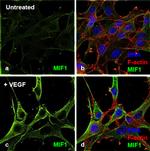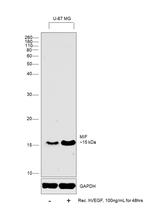Search Thermo Fisher Scientific
FIGURE: 1 / 2
Human VEGF-165 Protein (PHC9391) in Functional


Product Details
PHC9391
Species
Published species
Expression System
Amino acid sequence
Molecular weight
Class
Type
Purity
Endotoxin concentration
Activity
Conjugate
Form
Purification
Contains
Storage conditions
Shipping conditions
Product Specific Information
Carrier-Free
Reconstitution: Centrifuge the vial briefly, before opening to bring the contents to the bottom. Reconstitute the lyophilized protein in sterile, distilled water or appropriate buffered solution containing 0.1% BSA to regain full activity. Make any further dilutions of the reconstituted protein in buffered solution containing a carrier protein such as PBS with 0.1% BSA.
Storage: Store the lyophilized protein at 2-8°C or -20°C for long term storage, preferably desiccated. Upon reconstitution, apportion into working aliquots and store at ≤-20°C. Avoid repeated freeze-thaw cycles.
Target Information
The vascular endothelial growth factor (VEGF) family currently includes VEGF-A, VEGF-B, VEGF-C, VEGF-D, VEGF-E, and PIGF. VEGF and its receptor system have been shown to be the fundamental regulators in the cell signaling of angiogenesis. Most tumors have the absolute requirement of angiogenesis and VEGF has been described as the most potent angiogenic cytokine linked to this process. To date 5 different isoforms of VEGF have been described. These isoforms are generated as the result of alternative splicing from a single VEGF gene. These various isoforms have been shown to bind to two tyrosine-kinase receptors flt-1 (VEGFR-1) and flk-1/KDR (VEGFR-2), which have been found to be expressed almost exclusively on endothelial cells.
For Research Use Only. Not for use in diagnostic procedures. Not for resale without express authorization.
Bioinformatics
Protein Aliases: H-VEGF-165; L-VEGF; M-VEGF-165; Vascular endothelial growth factor A, long form; vascular endothelial growth factor A121; vascular endothelial growth factor A165; Vascular permeability factor; VEGF165; VPF
Gene Aliases: MVCD1; VEGF; VEGFA; VPF
UniProt ID: (Human) H3BLW7
Entrez Gene ID: (Human) 7422

We're here to help
Get expert recommendations for common problems or connect directly with an on staff expert for technical assistance related to applications, equipment and general product use.
Contact tech support
